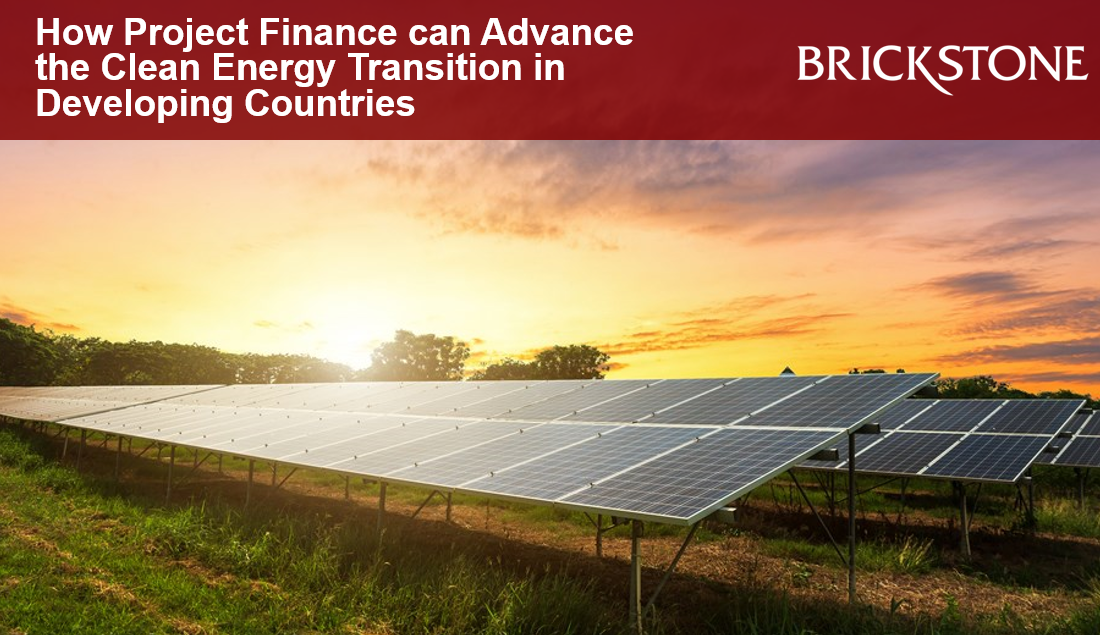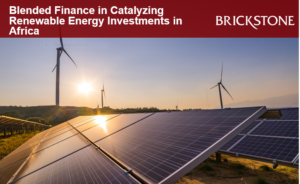How Project Finance Can Advance the Clean Energy Transition in Developing Countries
Project Finance In The Clean Energy Transition
According to the Oxford Institute For Energy Studies, the world climate imperative requires a substantial increase in clean energy investments across middle- and low-income countries (“MLICs”), where energy demand growth and limited financial resources compound the problem.
It is a particular challenge for these countries because of the scale and nature of the investment needed, particularly in power and other infrastructure projects. Infrastructure investment in any country requires long term debt, but local debt markets are limited and foreign debt can expose the project and its lenders to an excessive level of currency risk.
In many MLICs, issues of political stability and rule of law add substantially to the challenge. As a result, international debt finance has made only a limited contribution to clean energy projects in the MLICs, with the risk that this may seriously constrain the level of investment to less than is needed to avert dangerous levels of climate change.
Project finance can help to address these challenges and increase funding for clean energy projects in MLICs because it enables separation and allocation of different risks to different parties. This can attract different funders with different risk appetites. It also provides the possibility for targeted credit enhancement products, such as those offered by the World Bank, ECAs and other governmental agencies looking to promote clean investments.
This article by Brickstone reviews Oxford Institute For Energy Studies‘s publication on how leveraging project finance can advance the clean energy transition in developing countries.
Role Of Project Finance In Advancing The Clean Energy Transition
The global climate change imperative presents a particular challenge because of the scale and nature of the investment needed in developing countries, coupled with the difficulty of raising long term debt in many of them. Accordingly, the IEA estimates that investments in clean energy in MLICs excluding China will need to increase by $450 billion p.a. by 2030 under the “well below 2oC” Sustainable Development Scenario (SDS), and by about $900 billion p.a. under the 1.5oC “Net Zero Emissions by 2050” (NZE) scenario.
Today, the total energy investments in these MLICs totals about $150 billion p.a. Moreover, China will need to invest by 2040 an additional $300 billion p.a. in its energy system to achieve its 2060 carbon neutrality goal. It has also been estimated that China will need $21 trillion in debt financing over the next 40 years to meet this goal.
To reach this investment need, project finance can help to address this challenge because it enables separation and allocation of different risks to different parties, which can help to attract different funders with different risk appetites. In particular, it is a vehicle to segregate green assets for funding and could assist in incorporating targeted credit enhancement products, such as those offered by the World Bank and other governmental agencies looking to promote clean energy investments.
The following are key insights from the publication:
Project finance is a well-established financial structure used to mobilize third-party debt on the basis of specific assets and revenues, rather than the corporate balance sheet of the project sponsor. While individual project finance structures might differ, there are several common elements. First is the segregation of project assets, often through the creation of a special purpose vehicle. Second is funding through a combination of sponsor equity and third-party debt. Third, and most importantly, is the segregation of cash flows through secured accounts and their attribution to project lenders on a priority basis.
Within this generic structure, details vary according to need, and to the differing objectives and constraints of the various players. These might include: sponsors, commercial lenders, international development and other public agency financial support, arrangers and advisers, and host governmental authorities (national and local). Project finance will attempt to combine these different groups to the project’s best advantage. In many cases a common terms agreement will provide for all lenders to share cash flows and risks on a common basis. In others, risks are allocated differently to different lender groups.
The project finance structure has a lot of benefits. This includes accessing long-term debt, creating bankability, reducing and managing risks, and the appeal of off-balance sheet financing. Also, in part because it provides assurance that funds are used only for a designated purpose, project finance can be an effective vehicle to enable funding and credit enhancements from PIFPs, such as multilateral and national development banks, development finance institutions, export credit finance agencies and other international sources of public international.
Despite these benefits, project finance, however also presents a variety of limitations and other constraints; particularly that it is time-consuming and expensive to set up. Many skills are required to develop and finance a new renewable power project including technical, economics, land acquisition and other local considerations, rule of law, finance and politics, as well as the overall project management to coordinate these skills toward a successful development.
A critical attribute of project finance in MLICs is its ability to attract long-term debt funding to projects whose sponsors (or any one of them) do not have access to debt themselves. This is particularly relevant for MLIC sponsors of clean energy investments that do not enjoy either the massive balance sheets or the creditworthiness of larger project sponsors in advanced economies. In many cases, the required clean energy investments exceed the balance sheets and borrowing capacities of MLIC project sponsors outside the oil and gas sector.
Project finance provides a mechanism to segregate low-carbon assets from more carbon intensive ones, which could help to attract the increasing investor interest in green assets. The project finance structure provides an effective tool for a sponsor to finance a limited set of green assets (e.g., a single or limited set of new renewable power plants). This could provide a way for projects to access a larger funding base by attracting specific capital investors or specialized and “green” dedicated sources of funding.
Project finance can be an effective tool to tap into domestic financial resources. Many project financings include both local and foreign lenders, with a local bank tranche with its own tenor, pricing and other terms, but where local banks can benefit from the structuring experience of the offshore banks, who in turn benefit from the local knowledge of the local banks. The opportunity to tap into under-exploited domestic investors such as pension funds and other sources of local savings may offer significant potential.
Looking at the total clean energy investment needed across all MLICs, it is unlikely that this will happen without substantial support from high income countries, whether directly and/or through various multilateral and national international finance institutions and public international finance providers (PIFPs). Raising and structuring this level of support will be challenging, necessitating leveraging each dollar of support to the maximum. Project finance has traditionally been used to leverage such support through various means, primarily with ECAs and, for lower income countries, DFIs.
Download the full publication here.






